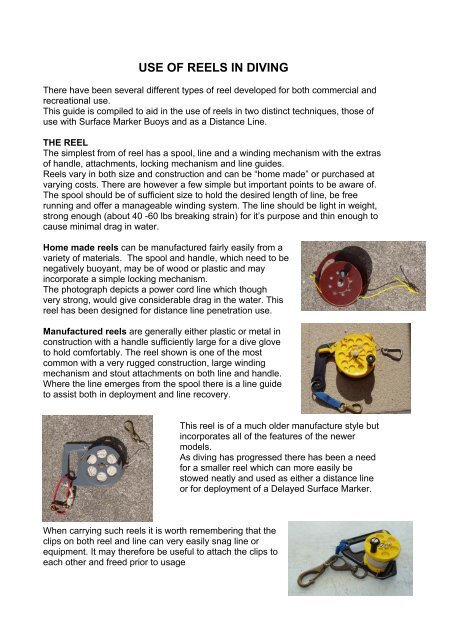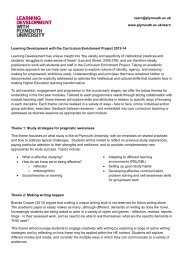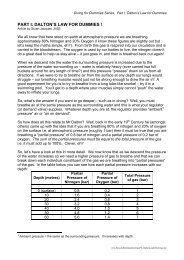Create successful ePaper yourself
Turn your PDF publications into a flip-book with our unique Google optimized e-Paper software.
USE OF REELS IN DIVINGThere have been several different types of reel developed for both commercial andrecreational use.This guide is compiled to aid in the use of <strong>reels</strong> in two distinct techniques, those ofuse with Surface Marker Buoys and as a Distance Line.THE REELThe simplest from of reel has a spool, line and a winding mechanism with the extrasof handle, attachments, locking mechanism and line guides.Reels vary in both size and construction and can be “home made” or purchased atvarying costs. There are however a few simple but important points to be aware of.The spool should be of sufficient size to hold the desired length of line, be freerunning and offer a manageable winding system. The line should be light in weight,strong enough (about 40 -60 lbs breaking strain) for it’s purpose and thin enough tocause minimal drag in water.Home made <strong>reels</strong> can be manufactured fairly easily from avariety of materials. The spool and handle, which need to benegatively buoyant, may be of wood or plastic and mayincorporate a simple locking mechanism.The photograph depicts a power cord line which thoughvery strong, would give considerable drag in the water. Thisreel has been designed for distance line penetration use.Manufactured <strong>reels</strong> are generally either plastic or metal inconstruction with a handle sufficiently large for a dive gloveto hold comfortably. The reel shown is one of the mostcommon with a very rugged construction, large windingmechanism and stout attachments on both line and handle.Where the line emerges from the spool there is a line guideto assist both in deployment and line recovery.This reel is of a much older manufacture style butincorporates all of the features of the newermodels.As diving has progressed there has been a needfor a smaller reel which can more easily bestowed neatly and used as either a distance lineor for deployment of a Delayed Surface Marker.When carrying such <strong>reels</strong> it is worth remembering that theclips on both reel and line can very easily snag line orequipment. It may therefore be useful to attach the clips toeach other and freed prior to usage
Use of <strong>reels</strong> can take several forms – to control asurface marker buoy, release and control a delayedsurface marker buoy or act as a distance line.Common to all systems though is the need to be ableto allow the line to run out freely. Thus it is necessaryto perform some basic maintenance on the equipment.The line should always be rewound onto the spool in auniform fashion and the spindle of the spool maintainedfree running.Soaking the reel in fresh water to remove salt will help to maintain it.DISTANCE LINESA distance line is a temporary marker of the shortest route between two points. Adistance line should be used to guarantee return to the start point, when visibility ispoor or for penetration diving.A reel when used as a distance line may be of the morecompact type (as shown) or large and robust dependingupon the terrain over which it will bedeployed.Lines which are run out throughwater can to be thinner and buoyant,(less drag) than those which need topass over or around solid materialssuch as on wreck sites or in caves.Such line will be heavier and perhapsweighted.Distance lines should always remain taught and be deployed from one side of thediver. The reel should NEVER be attached to you as you are then effectivelyanchored to the site. If suitable attachment points are available fasten the distanceline to them with either simple knots or wire closures.It is essential that distance lines are controlled at all times otherwise there is a veryreal danger of entanglement. As a safety precaution a sharp knife should always becarried.The initial attachment of the distance lineshould be by passing the line around thefixed point twice and then clipped to itself.Clipping directly to rope such as a shot linemay prove to be very difficult to unfasten later.WRONG
A Distance line may be required during low visibility ornight diving. In this case the task can beimproved by illuminating the line as it is deployedby use of a small torch fastened to the handle.SURFACE MARKER BUOYSThere are two different types of Surface Marker Buoy –fixed and delayed.The fixed SMB is an essential part of Commercialdiving when lifelines are not used. It is arequirement of the <strong>Diving</strong> at Work Regulations 1997.Delayed SMBs tend to be used in Recreationaldiving and Instructing, allowing the diver morefreedom during the dive but allowing surface coverto be alerted for the final ascent.Fixed SMBThe standard SMB at the <strong>University</strong> of <strong>Plymouth</strong> is analuminium pole passed through a rigid red plastic ball whichprovides buoyancy.At the top of the pole is a code Alpha flag indicatingunderwater operations. The pole height assists with divermonitoring in choppy conditions.The base of the pole offers a ring for the attachment of thereel line.During night diving a light stick is fastened to the top of thepole.For ease of identification of individual divers the SMB polesare coloured or banded.Other fixed SMBs may be circular or tube shaped but shouldhave a sealed air supply.The best colour providing the highest visibility is a brightred/orange.
Delayed SMBThe delayed SMB is generally of a very compact nature and convenientlyCarried either in a Stab jacket pocket or attached to external equipmentdesigned for the purpose.As the system is designed to be inflated underwaterthe float needs to have a mechanism for release ofover pressured gases.This may be as simple as an open end to thefloatation tube marker or a side mounted dump valve.The open ended tube system often is supplied with a weighting at the mouth of thetube.Floats designed to retain their air have a one way closure system at the open endwhich becomes self sealing once air is admitted. By applying Boyles Law to the floatas it ascends from depth is easy to understand the need for a dump valve.Both open and sealed floatation tubes require gas to be added to them from thediver’s supply. This would best be performed from a redundant source rather thanthe main supply and using an alternative means of filling rather than the primaryregulator.There is a type of DSMB which has it’s own airsupply in a small cylinder. This extra equipmentwill add to the weight of the system and it willrequire charging in the normal way prior to adive.As air will be released rapidly into the float, thissystem is best securely anchored at depth priorto inflation.Note the dump valve situated adjacent to theinflation inlet.The simplest form of a Delayed SMB comes in the form of a pieceof emergency equipment consisting of an inflatable tube with tenmetres of line attached to a weight.The line is carefully wound around the weight. The marker tube iswound into a cylinder shape and stored with the weight attached asshown. The system is small and light enough to be carried in a stabjacket pocket and is to provide the diver with an emergency meansof surface cover.The weighted line is first deployed prior to inflation of the marker.
Using a Surface Marker BuoyIt is important to control a surface marker buoythroughout a dive, taking particular care to ensurethat the marker remains on the surface and is nottaken diving with you.This control is essential during ascent whenseveral factors may come into play.These may include personal buoyancy control,monitoring speed of ascent, checking buddy,communication with topside as well as possiblyrecovering task tools.However topside is only aware of your position bythe position of the SMB. Consequently the bestposition for you is directly under the SMBespecially when there is a large amount of surfacetraffic.
















